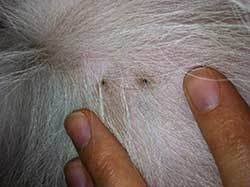We all have a general idea on how miserable life can get when dealing with a bed bug infestation. This raises a thought-provoking question about the impact of these pesky, scary critters on your dog.
Like us, dogs suffer from bedbugs and can make their life a nightmare. Bed bug bites can also bring them skin infections. As a dog owner, there is no better way to spend your time than reading this to prevent your dog from experiencing this.
Table of Contents
Will Bed Bugs Bite Dogs?
Fleas and ticks are the first things that come to mind when you think about pests feeding on your dog. While these pests are at the top of the list of pest problems on your dog, bed bugs are just as problematic. These pesky critters prefer human blood because it offers sufficient nutrition but they can feed on your canine friend in exigent circumstances. Runaway bed bug populations will lead to insufficient human blood supply, forcing bed bugs to feed on your dog.
There is good and bad news when dealing with bed bug infestations and dogs. The good news is that bed bugs do not live on your dog and do not transmit diseases. Bed bug bites on dogs are rear but, they pose significant health concerns because they are hard to spot. If left untreated, bed bug bites can cause your dog lots of distress because they can cause:
- Uncomfortable itchiness
- Skin infections
How to Know If Bed Bugs are Biting Your Dog
There is something disturbing about the thought of bed bugs feeding your canine friend. Unfortunately, it is pretty challenging to tell whether your dog has a bed bug problem because their bites often resemble other pests. Here are some ways to know if your dog has a bed bug problem:
Searching for bed bug bites on your dog
According to this interesting National Geographic video, bed bugs inject an anesthetic that prevents hosts from filling pain. When I speak of hosts, most people think of humans, but the same principle applies to dogs. A bed bite on a dog is painless but it often leaves behind a reasonable mark. This raises the question, how do you identify a bed bug bite on your dog and differentiate it from other pest bites?
When bed bugs bite you, red welts organized in a distinctive pattern often appear on your skin. You will notice similar bite marks on your dog if you move its fur out of the way. It is wise to remember that bite marks from other popular pests such as flea may appear similar to bed bug bites. Bed bugs typically bite dogs on limps and the belly area.
If you find bed bug bite marks on your dog, it is safe to conclude that they are hiding somewhere your dog frequents. Some of the places and things you need to inspect include the dog house, the dog’s toys, and its bed. Bed bugs are good at hiding but they often live behind some signs of their presence, which leads us to our next point.
Look for signs of bed bugs
Strange behavior in your dog such as persistent scratching and gnawing warrants a search for signs of bed bugs. These tiny critters are the size of an apple seed and like to hide in dark spots. It is unlikely that you will find an actual living bed bug but leave behind some signs that alert you to their presence. These signs include:
- Exoskeletons – Like other insects, bed bugs shade exoskeletons as they transition from one phase to another during the nymph stage. Sightings of these bed bug-like translucent skins around your bedding are an indicator that you have a bed bug problem. Bed bug exoskeletons are challenging to see but a UV flashlight will make it easier for you to notice them.
- Fecal spotting – Bed bugs consume blood and excrete fecal matter that appear as tiny dark spots. With the help of a magnifying glass, you will notice these spots on your bed, if you have a bed bug problem.
- Bed bugs – It is not easy to find a living bed bug crawling around your dog’s belongings, but it doesn’t hurt to look. Focus your search on dark and hard to reach spots such as bed frames when looking for live bed bugs.
How to Keep Bed Bugs off Your Dog
Reaction to bed bug bites tend to vary from one dog to another. The most likely reactions include:
- Rashes and blisters
- Itching that may lead to extreme scratching
- Lose of patches of fur
This reactions lead to anxiety and mental distress as a result of the discomfort associated with them. Prevention is better than cure. Thus, you need to keep bed bugs off your dog by keeping these pestilent critters off your home. You can do this by:
Employing effective bed bug monitoring tools
According to a recent report, detection of infestations based exclusively on bed bug bite marks is inadequate. By the time you notice the bite marks, it may be too late, hence the need to employ bed bug monitoring tools. Such tools attract or intercept and trap bed bugs, keeping them off your dog, yourself and the rest of your family. Bed bug monitoring using traps or any other tools is also instrumental in preventing the spread of infestations.
Staying vigilant in hotels and other public spaces
Bed bugs are hitchhikers and therefore, it is commonplace to find them in public places frequented by different people. You must stay vigilant and take precautions to avoid getting bed bugs from hotels and other public spaces. Visit our bed bug page to learn how to avoid getting bed bugs in or from places such as:
- Movie theaters
- Friends’ houses
- Airbnbs
- Public Transport
- Nursing homes
- Apartments
Treatment Protocol If Your Dog Has Bed Bugs
Most people make mistakes when treating bed bugs because they allow themselves to be overtaken by fear. If you discover that your dog has bed bugs you should calm down, and take all necessary treatment measures. Here is a comprehensive guide on what to do if your dog has bed bugs:
Treat bed bug bites on your dog
Although bed bugs do not transmit diseases, their bites can cause serious issue for your dog. Persistent scratching as a result of itching may lead to life-threatening skin infections. There is no treatment for bed bug bites; all you can do is to soothe the itching and safe your dog from further turmoil.
There are several methods to relieve irritation arising from bed bug bites. A Racine County Eye post suggests:
- Applying an ice park on the affected area
- Applying baking soda on areas with bite-marks
- Bathing your dog with oatmeal
You must be keen to avoid soothing products that may harm your dog. Products that work on humans or other pets may not be safe for dogs. For example calamine lotion contains zinc, which is harmful to dogs.
Wash your dog’s beddings and any other washable items
If your dog has bed bugs, they are likely hiding in its bedding, toys, and anything else it comes in contact with. You must wash all washable items in hot water and place them in a hot dryer. Heat treatment is a highly effective method of treating bed bugs.
When using heat to kill bed bugs, you must consider the fact that bed bugs go through different stages in their life cycle. Bed bug eggs are more challenging to kill than adult bed bugs. Adult bed bugs die at 119°F (48°C) while eggs require temperatures above 125°F (51°C).
Clean your home and treat it for bed bugs
Washing your dog’s belongings is not sufficient to protect it from bed bugs. If bed bugs bite your canine friend, there is a significant chance that your home is infested. Follow these tips to clean your home:
- Strip your beds of all bedding. Ensure only the sleeping surface is visible
- Wash the beddings and any clothing that may have been exposed to bed bugs in hot water.
- Vacuum all surfaces are your home and ensure that you reach all hidden surfaces
- Once you finish vacuuming, seal the vacuum bag tightly and dispose it
Once you finish cleaning your house, you can implement some bed bug treatment options. Using pesticides is not a wise choice because they have been proven to be less effective against bed bugs. More importantly, Dr. Wismer of ASPCA notes that pesticides are harmful to pets such as dogs. You should consider using safe bed bug treatment options such as Diatomaceous Earth.
Final Thoughts
Dogs are an integral part of part of any family. If you have a bed bug problem, you need to do whatever it takes to keep them off your dog.
The key takeaways from this post concerning how to protect your dog include:
- Early detection using bed bug monitoring tools can save you and your dog
- Identifying bed bug bites is not always easy because they resemble bites from other pests such as fleas and ticks. When you notice bite marks, look for other clues such as fecal spots, exoskeletons, and live bed bugs.
- You must be keen when choosing treatment products for your dog. Some treatment products which are ideal for us can be harmful to dogs
FAQs
Can my dog carry bed bugs?
Unlike fleas and ticks, bed bugs do not live on your dog’s fur. However, your dog can carry bed bugs in its collar.
Does Frontline pesticide kill bed bugs on my dog?
Flea and tick treatments such as frontline pesticide are not effective against bed bugs. It is also unwise to use pesticides on your dog because they can cause serious harm.
How long will bed bugs live on my dog?
Bed bugs do not live on hosts whether it is a human or a pet. Bed bugs live in hidden spots around your dog’s resting place.
Can my dog get bed bugs at the groomer?
No, it can happen but it’s unlikely. Bed bugs don’t live on pets nor like to hitch a ride on them unlike the more common pests such as fleas and ticks.


